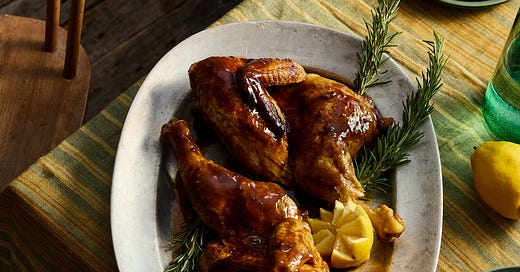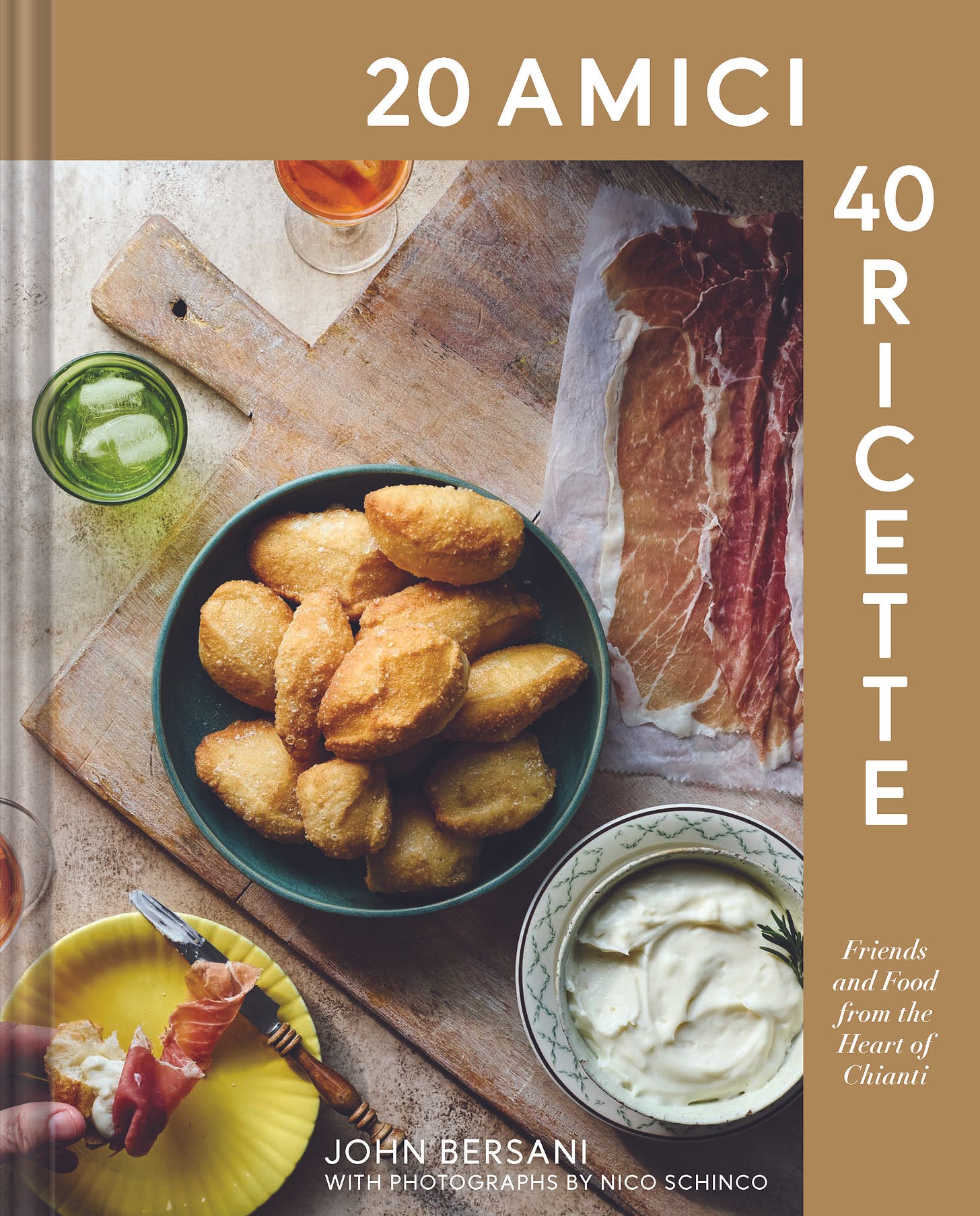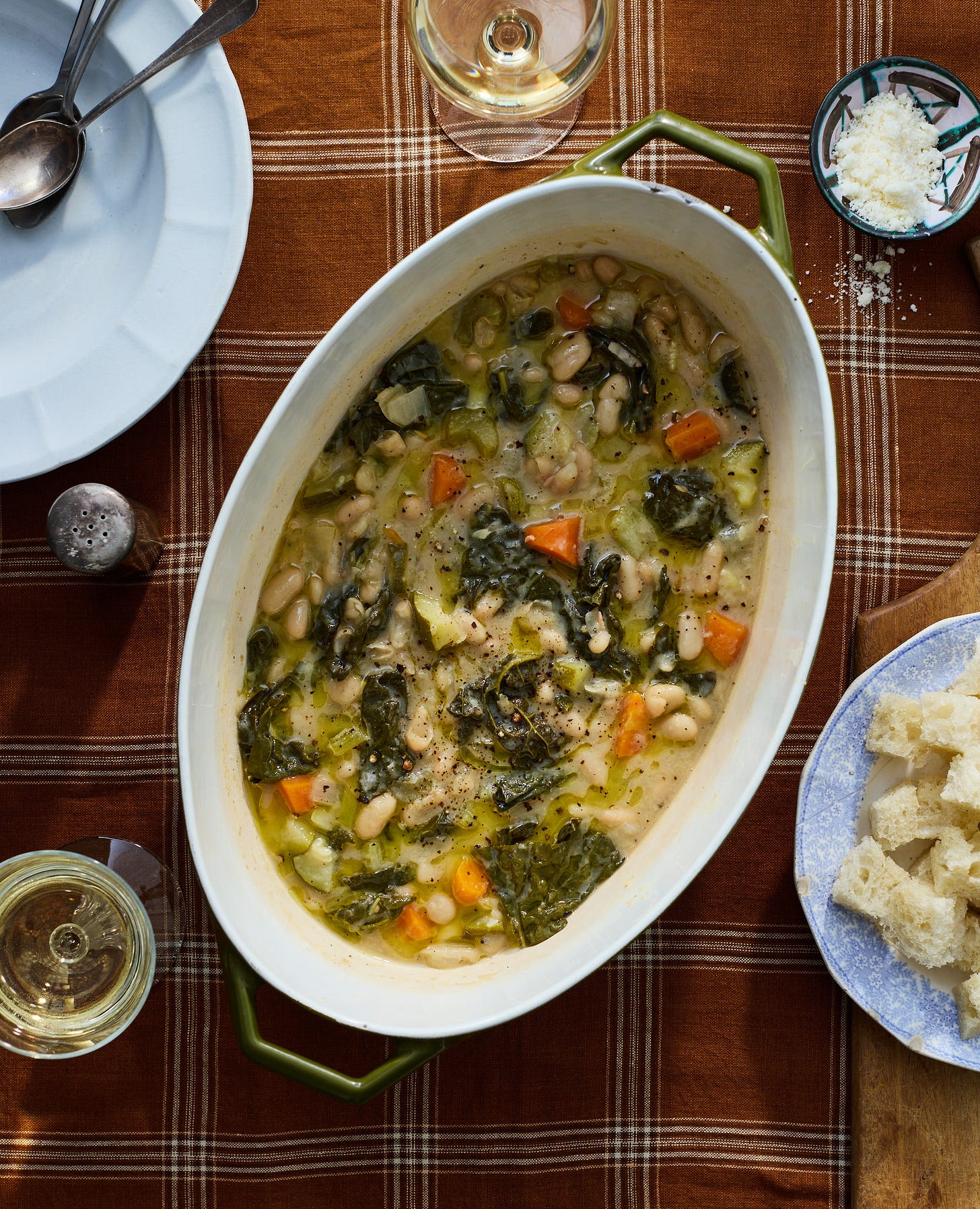Braised Drunken Chicken and a Great Use for Day-Old Bread
Two recipes from John Bersani’s 20 Amici, 40 Ricette
A little bonus today courtesy of John Bersani, the author of 20 Amici, 40 Ricette: Friends and Food from the Heart of Chianti. This book is a journey to the village of Gaiole in central Tuscany, where Bersani has lived for the past two decades.
20 Amici, 40 Ricette brings you into the kitchens of local chefs and home cooks, and I’ll warn you that the gorgeous photography may convince you to plan a trip.
In the meantime, though, you can add this chicken braised with white wine, lemon, and rosemary to your dinner lineup—plus a classic cozy kale and white bean soup that’s filled out with yesterday’s bread. No bread on hand? John grants you permission to skip that part as needed.
Galletto ‘Briaco / Braised Drunken Chicken
Excerpted from 20 Amici, 40 Ricette: Friends and Food from the Heart of Chianti by John Bersani. Copyright © 2025. Reprinted by permission of The Collective Studio. All rights reserved.
One of the house specialties at I’ Galletto is its namesake dish, the galletto ‘briaco, literal translation: “drunken rooster.” The recipe, a more or less well-kept secret, is a mix of herbs, aromatics, and wine that combine to produce a uniquely flavorful braise. But I believe the essence of the dish is intact in my take on the trattoria’s original
SERVES 4 TO 6
1 (4- to 6-lb/1.8- to 2.7-kg) whole chicken, backbone removed and halved
Kosher or coarse sea salt and freshly ground black pepper
2 garlic cloves, crushed
4 sprigs fresh rosemary, divided
¾ cup (180 ml) extra-virgin olive oil, divided, plus more as needed
2 cups (480 ml) dry white wine (something you’d be happy to drink)
1 lemon, cut into ½-inch (1.3-cm) slices
Season the chicken halves generously with salt and pepper. Place the chicken in a large plastic or nonreactive container that has a cover. Add the garlic, 2 sprigs of the rosemary, ½ cup (120 ml) of the olive oil, 1 cup (240 ml) of the white wine, and the lemon slices to the container. Mix well with your hands to thoroughly coat the chicken halves. Cover tightly and refrigerate for at least 4 hours or preferably overnight.
Remove the chicken from the refrigerator about 2 hours before you plan to begin cooking to bring it up to room temperature.
Remove the chicken from the marinade and wipe clean with paper towels.
In a skillet or sauté pan large enough to accommodate the two chicken halves in one layer, heat the remaining ¼ cup (60 ml) of olive oil over medium-high heat until it begins to shimmer.
Add the chicken halves to the pan, skin-side down, and cook until the skin takes on a deep golden-brown color, 5 to 7 minutes. Flip the chicken halves and continue cooking for another 2 minutes.
Add the remaining 1 cup (240 ml) of white wine to the pan, allow it to come to a boil, and scrape the bottom of the pan with a wooden spoon to loosen all the caramelized bits. When all the alcohol in the wine has burned off and you can no longer smell the vapors coming off of the pan, adjust the heat to low and cover the pan.
Cook at a very low simmer for about 40 minutes. Check the pan every 10 minutes or so to make sure that there is still some liquid in the bottom of the pan. You want enough liquid to continue the cooking and to eventually create a syrupy sauce for the finished dish, but not so much liquid that the final result will be watery. If necessary at any point, add 2 to 3 tablespoons (30 to 45 ml) of water to the pan to keep things from becoming too dry. Conversely, if there seems to be too much liquid in the pan, especially toward the end of the 40-minute cooking time, remove the lid from the pan and continue cooking. This should help slowly reduce the amount of liquid in the pan. Turn off the heat and let the chicken rest in the covered pan for 10 to 15 minutes.
Transfer the chicken halves to a warmed serving platter, spoon the pan sauce over the top, and drizzle with a bit of olive oil. Nestle the remaining 2 sprigs of fresh rosemary in beside the chicken and serve immediately family-style.
Make It a Meal: Pair this “drunken chicken” with a side of sautéed green beans, garlic, scallions, and cherry tomatoes for a wholly satisfying dinner.
Wine Pairing: Rocca di Castagnoli Chianti Classico Riserva DOCG “Poggio A’ Frati” 2018. This Chianti Classico riserva, produced just ten minutes away from Sabatino and Jenni’s trattoria by one of Gaiole’s signature producers, is a gutsy counterbalance to the wine and herb–marinated chicken.
Win a copy of 20 Amici, 40 Ricette
Here’s how to enter to win your own copy of the book.
Make sure you’re subscribed to The Dinner Plan.
Click the heart icon at the top or bottom of this newsletter.
Leave a comment below.
Book giveaway winner will be alerted by DM and email—be sure to check your messages! U.S. addresses only, 18+, no purchase necessary. Giveaway not sponsored or administered by Substack or Instagram. Ends Tuesday, April 15, 2025.
Thanks to John Bersani for supporting The Dinner Plan and sponsoring this giveaway.
La Ribollita / Tuscan Black Kale and Bean Soup
Excerpted from 20 Amici, 40 Ricette: Friends and Food from the Heart of Chianti by John Bersani. Copyright © 2025. Reprinted by permission of The Collective Studio. All rights reserved.
No book about regional Tuscan cuisine would be complete without a recipe for the classic ribollita. It’s a hearty vegetable soup with cannellini beans and cavolo nero taking the starring roles. Once it’s finished, the soup is usually fortified by the addition of Tuscan bread. And in the most traditional renditions, it’s left to cool and meld together overnight, then reheated in a pan (the literal translation of ribollita is “reboiled”) just before serving.
Personally, I prefer my ribollita without the bread, and many restaurants offer the dish “con or senza pane,” with or without bread. Of course, purists will say that without the bread it’s no longer ribollita, it’s just a “minesetra” (plain old soup.) But hey—it’s all about personal preference.
SERVES 6
3 medium carrots
4 medium zucchini
3 medium yellow onions
4 medium celery stalks
½ cup (120 ml) high-quality extra-virgin olive oil
2 to 3 tablespoons (30 to 45 g) butter
3 large bunches Tuscan black kale (cavolo nero)
6 (1-lb/455-g) cans cannellini or navy beans (preferably packed in their own juices)
4 or 5 cherry tomatoes
5 cups (1.2 L) chicken or vegetable stock or water
Kosher or coarse sea salt and freshly ground black pepper
3 or 4 slices 2- or 3-day-old rustic country bread (optional)
Parmigiano-Reggiano cheese (optional)
Cut the carrots, zucchini, onions, and celery into equal bite-size pieces. Place the vegetables into a stockpot large enough to hold the finished soup. Add the olive oil and butter to the pot. Warm the contents of the pot over medium-low heat. You want the vegetables to begin to soften and become translucent—they should not caramelize or take on color.
Meanwhile, chop the Tuscan kale into 1-inch (2.5-cm) wide strips. Add the chopped kale to the pot and stir to combine. Continue cooking the mixture until the kale has wilted and melded in with the rest of the vegetables.
Drain and rinse the beans thoroughly. Add two-thirds of the beans to the vegetable mixture and stir well to combine. Quarter the cherry tomatoes and add them to the pot. Add the stock to the pot until the liquid just covers the vegetables. Bring the pot to a boil and then lower the heat to a steady simmer. Add salt and pepper to taste.
Place the remaining one-third of the beans in a bowl or tall container and puree to a smooth consistency with an immersion blender. If you don’t have an immersion blender, you can use a regular blender or a food processor. Or you can just break the beans up and mash them using a fork or other utensil. Add the bean puree to the pot.
Allow the entire mixture to simmer slowly until the vegetables and kale are soft and the liquid has taken on the consistency and taste of a broth, about 1 hour. If the soup seems too thick, add a bit more water. If it seems too thin, continue to cook and reduce the liquid a bit longer. Taste for seasoning and add more salt and pepper if needed. If serving without the addition of bread, ladle the soup into individual serving bowls, drizzle with extra-virgin olive oil, and grate some Parmigiano-Reggiano cheese on top, as an option.
If using bread, remove and discard the crust and cut the remaining interior crumb of the bread into small pieces. Add the bread to the soup and stir to combine well. Continue to cook until the bread has broken down, incorporated itself into the soup and thickened the mixture. Ladle the soup into individual serving bowls, drizzle with extra-virgin olive oil, and grate some Parmigiano-Reggiano cheese on top, if using.








This is exactly what I want my chicken to be like -- braised, saucy, and a little bit boozy.
That chicken is my kind of comfort food.